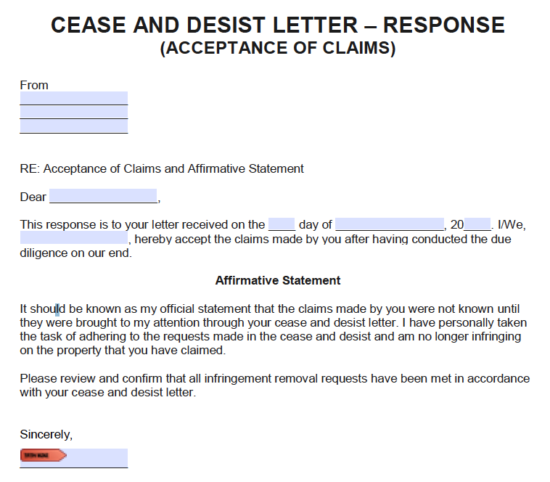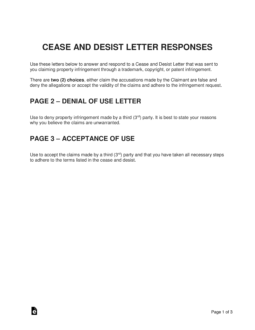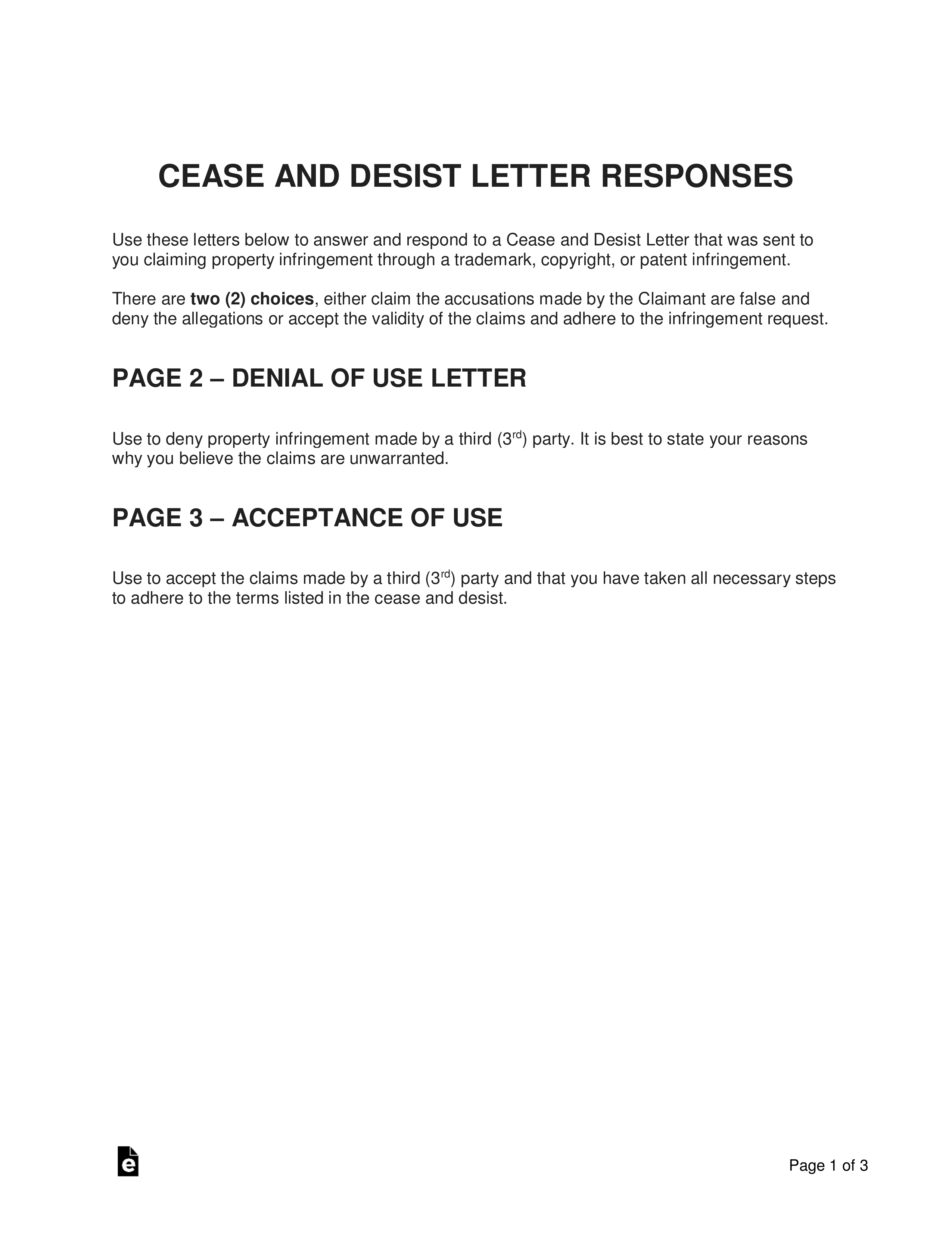Updated June 23, 2023
A cease and desist letter response is a form intended to answer any claims made by another party in regards to an infringement of property. This is common with trademark, copyright, or patent claims whereas a party believes that someone else is using conducting an activity that “dilutes” their brand or they believe is outright stealing their unique product or service.
Response Time – If a cease and desist letter has been claimed upon you it should be recommended that it is resolved as soon as possible in order to avoid litigation.
Templates
Response Letter Accepting Claims – This consents to the fact that the statements made in the cease and desist letter are valid and that the recipient agrees to adhere to all claims.
Response Letter Denying Claims – Reject the claims made in a cease and desist letter. It verifies that notification has been made of property infringement and states why the claims are invalid.
Table of Contents |
How to Respond to a Cease and Desist
When a cease and desist arrives in the mail it can cause overwhelming feelings. In most cases, the party that is sending the cease and desist is asking for a person or company to stop what they’re doing. Different from a claim or case filing, the positive side of a cease and desist is that as long as the person pauses their current actions, due to whatever the case, they will be able to rectify any claims.
Step 1 – Read the Cease and Desist Thoroughly

When the letter arrives, make sure to read through it entirely and study the precise demands that the sender is requesting. There are usually demands to stop doing something that must be done within a specific time period, usually immediately, in order to comply with the letter. Once an understanding has been made of the terms, it’s best to assess the situation and think about what to do.
If the letter was sent via Certified Mail with Return Receipt, the sender will be officially notified that the letter was delivered and received by the recipient.
Step 2 – Request Legal Assistance

Most law firms, whichever the legal field, will commonly grant one (1) free consultation if the recipient of the letter feels that they may have a case. If not, it’s convenient to hear a legal professional’s advice on how they would proceed with the letter that was received.
Step 3 – Contact the Sender

Responding to the sender can be a good way to understand how serious the matters are and to see where the recipient stands. If the sender responds in an aggressive tone then maybe it’s best to take them seriously. When contacting, it’s best to make counter-claims and see exactly the information that is against the recipient.
Step 4 – Decide the Next Move

There are two (2) options:
1.) Deny the Claims – This will usually require legal counsel. If the recipient decides to refute the facts they may do so in a letter to the sender. Furthermore, if a Complaint or similar filing has been made the recipient will have the right to file an Answer or make a counter-claim. This will most likely enter a lengthy legal process if the parties cannot come to an agreement.
2.) Accept the Claims – Write a letter responding to the cease and desist with a letter that states if the recipient no longer continues their stated action that they will be held harmless against such claims. This way, even if the recipient did not act appropriately, they will still be able to get out of the situation harmless by admitting fault yet being held harmless to any claims.
Step 5 – Negotiate and Obtain a Hold-Harmless Agreement

Whether or not the recipient accepted or denied the claims, a Hold-Harmless Agreement should be authorized to limit the legal liability of the parties. If there are any other stipulations made by the sender they should be adhered to in order to finalize the matter. At this time, there should be no obligations by or to either party.
Sample Denial of Claims
CEASE AND DESIST LETTER – RESPONSE
(DENIAL OF CLAIMS)
From
[SENDER NAME]
[SENDER ADDRESS]
RE: Denial of Claims and Affirmative Statement
Dear [NAME OF RECIPIENT],
This response is to your letter received on the [DAY] day of [MONTH], [YEAR]. I/We, [SENDER NAME], hereby deny each and every allegation set forth in your cease and desist letter, including but not limited to the following:
[LIST OF ALLEGATIONS]
Affirmative Statement
The following factors demonstrate our legal use:
[LIST FACTORS]
For these reasons it has been concluded that the claims made in your cease and desist letter are invalid.
Sincerely,
[NAME OF SENDER]
Sample Acceptance of Claims
CEASE AND DESIST LETTER – RESPONSE
(ACCEPTANCE OF CLAIMS)
From
[NAME OF SENDER]
[SENDER ADDRESS]
RE: Acceptance of Claims and Affirmative Statement
Dear [RECIPIENT NAME],
This response is to your letter received on the [DAY] day of [MONTH], [YEAR]. I/We, [NAME OF SENDER], hereby accept the claims made by you after having conducted the due diligence on our end.
Affirmative Statement
It should be known as my official statement that the claims made by you were not known until they were brought to my attention through your cease and desist letter. I have personally taken the task of adhering to the requests made in the cease and desist and am no longer infringing on the property that you have claimed.
Please review and confirm that all infringement removal requests have been met in accordance with your cease and desist letter.
Sincerely,
[NAME OF SENDER]
How to Write a Response Letter
Determine which type of letter you will be writing.
There are two (2) choices:
Denying Claims – State the reasons why the claims made against you are not justified; or
Admitting Claims – Agreeing to stop using the property that is being infringed upon.
Denying Claims
Step 1 – Download in PDF, Microsoft Word, or Open Document Text (.odt).
Step 2 – Enter the following information:
- Header – Name and Address of the party that is writing the response;
- Dear _________, – The name of the party that is being answered;
- Date – Day the cease and desist was received;
- I/We – Enter the your name;
- Claims – Enter the claims and allegations being made in the cease and desist;
- Affirmative Statement – Enter the your claims and reasons why you have the right and entitled to use the property.
Step 3 – Send the letter to the appropriate party as stated in the original cease and desist. It may be recommended to hire legal counsel as rejecting the claims in a cease and desist usually involve litigation.

Accepting Claims
Step 1 – Download in PDF, Microsoft Word, or Open Document Text (.odt).
Step 2 – Enter the following information:
- Header – Enter the Name and Address of the responding party (or Defendant);
- Dear _________, – Enter the name of the party the letter is responding;
- Receiving Date – The day the cease and desist letter was received;
- I/We – Enter your name or business entity;
- Allegations – Write the allegations you are denying in detail; and
- Signature – Sign the bottom of the letter.

Step 3 – Make sure to send the letter after the necessary tasks are completed as written in the cease and desist letter that was received.


